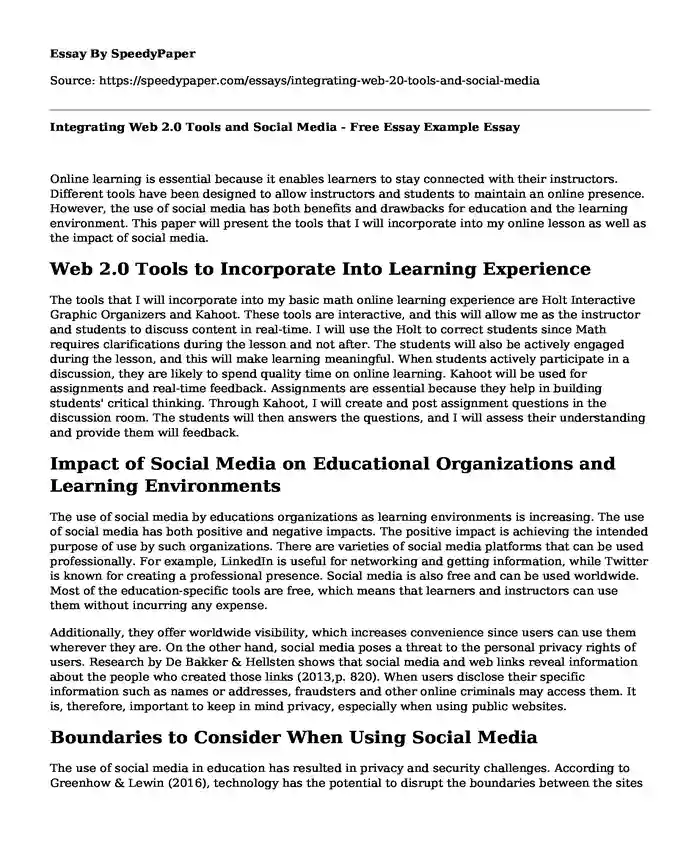
| Type of paper: | Essay |
| Categories: | Learning Internet Software Social media |
| Pages: | 3 |
| Wordcount: | 609 words |
Online learning is essential because it enables learners to stay connected with their instructors. Different tools have been designed to allow instructors and students to maintain an online presence. However, the use of social media has both benefits and drawbacks for education and the learning environment. This paper will present the tools that I will incorporate into my online lesson as well as the impact of social media.
Web 2.0 Tools to Incorporate Into Learning Experience
The tools that I will incorporate into my basic math online learning experience are Holt Interactive Graphic Organizers and Kahoot. These tools are interactive, and this will allow me as the instructor and students to discuss content in real-time. I will use the Holt to correct students since Math requires clarifications during the lesson and not after. The students will also be actively engaged during the lesson, and this will make learning meaningful. When students actively participate in a discussion, they are likely to spend quality time on online learning. Kahoot will be used for assignments and real-time feedback. Assignments are essential because they help in building students' critical thinking. Through Kahoot, I will create and post assignment questions in the discussion room. The students will then answers the questions, and I will assess their understanding and provide them will feedback.
Impact of Social Media on Educational Organizations and Learning Environments
The use of social media by educations organizations as learning environments is increasing. The use of social media has both positive and negative impacts. The positive impact is achieving the intended purpose of use by such organizations. There are varieties of social media platforms that can be used professionally. For example, LinkedIn is useful for networking and getting information, while Twitter is known for creating a professional presence. Social media is also free and can be used worldwide. Most of the education-specific tools are free, which means that learners and instructors can use them without incurring any expense.
Additionally, they offer worldwide visibility, which increases convenience since users can use them wherever they are. On the other hand, social media poses a threat to the personal privacy rights of users. Research by De Bakker & Hellsten shows that social media and web links reveal information about the people who created those links (2013,p. 820). When users disclose their specific information such as names or addresses, fraudsters and other online criminals may access them. It is, therefore, important to keep in mind privacy, especially when using public websites.
Boundaries to Consider When Using Social Media
The use of social media in education has resulted in privacy and security challenges. According to Greenhow & Lewin (2016), technology has the potential to disrupt the boundaries between the sites where learning takes place. For this reason, instructors need to set boundaries when using social media in learning. One of the boundaries that instructors can consider relates to the tools selected. It is important to consider which social media to use professionally without affecting students' privacy or security. For example, in the study by Greenhow& Lewin (2016), teachers opted for education-specific tools such as Edmodo due to security concerns and the school's decision to block some platforms such as Facebook. The other boundary to consider is the information to disclose when using social media. Instructors must consider privacy guidelines such as FERPA and avoid using students' information on public websites.
References
De Bakker, F. G., & Hellsten, I. (2013). Capturing online presence: Hyperlinks and semantic networks in activist group websites on corporate social responsibility. Journal of Business Ethics, 118(4), 807-823. doi:10.1007/s10551-013-1962-1
Greenhow, C., & Lewin, C. (2016). Social media and education: Reconceptualizing the boundaries of formal and informal learning. Learning, Media, and Technology, 41(1), 6-30. doi:10.1080/17439884.2015.1064954
Cite this page
Integrating Web 2.0 Tools and Social Media - Free Essay Example. (2023, Aug 20). Retrieved from https://speedypaper.com/essays/integrating-web-20-tools-and-social-media
Request Removal
If you are the original author of this essay and no longer wish to have it published on the SpeedyPaper website, please click below to request its removal:
- Search Paper Sample: Information Technology in Healthcare
- Free Essay Sample on Software Maturity Model
- Free Essay. Raspberry Pi 3 B+ Security Camera
- Free Essay - Role of Educational Leaders in the Future Schools
- Essay Example. Functionalism and AI
- Raising Gifted Children - Free Essay Sample
- Transforming Organizational Dynamics: A Journey from Tradition to Learning - Free Paper
Popular categories




